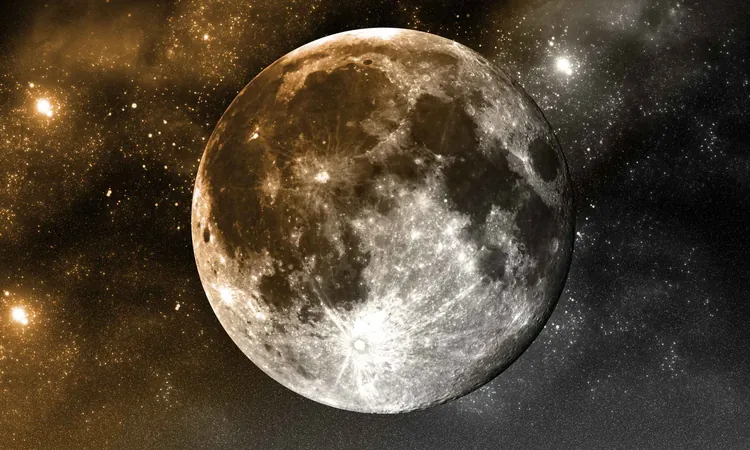
NASA Sounds Alarm: Moon Dust Could Create Toxic Atmosphere for Future Astronauts!
2024-12-28
Author: Wei
NASA Sounds Alarm: Moon Dust Could Create Toxic Atmosphere for Future Astronauts!
As plans to return to the Moon accelerate, with a timeline set for the end of this decade, experts are raising red flags about potential hazards that could arise from human activities. Recent warnings indicate that our presence on the lunar surface could inadvertently lead to the formation of short-lived, toxic atmospheres composed of lunar dust, known as regolith, right above the surface.
The Moon's atmosphere is currently extremely thin, consisting mainly of an exosphere—a sparse layer of gas that barely exists. However, the influx of astronauts, mining operations, and rocket launches may disturb this delicate balance, propelling significant amounts of moon dust into the air and threatening both ongoing missions and equipment safety.
Rosemary Killen, a prominent planetary scientist at NASA’s Goddard Space Flight Center, has expressed particular concern over the tiny, omnipresent dust particles that could be dislodged during these activities. “One thing that really worries us is that the dust raised by the explorers and so on will be loaded,” she explained, highlighting the threats posed to human health and mission integrity.
The Dangers of Moon Dust
Moon dust, or regolith, has developed over billions of years from collisions with space debris and the effects of solar wind. Once unsettled, its fine particles can pose serious health risks, potentially affecting astronaut visibility, respiratory health, and the functioning of essential electronic equipment. The dust can be exacerbated by exhaust from rocket boosters and rovers, which may also mix with gases from exhalations, spacecraft leaks, or from life support systems – creating temporary, toxic clouds in a place where every inhalation matters.
Though these gas additions may be fleeting, they have the capacity to spread over considerable distances before settling, causing concern for ongoing lunar research and exploration.
Impact on Lunar Research
Scientists are eager to explore ancient lunar ice trapped in permanently shadowed craters, believed to hold significant insights into the origins of water on both the Moon and Earth. However, any human-introduced water vapor could muddle these critical investigations by freezing in the same areas and obscuring vital chemical evidence.
Moreover, instruments designed to study the Moon’s atmosphere may be compromised by unintended contamination from human activities. As NASA and its commercial partners work towards the ambitious Artemis missions, they are mindful of the need to minimize these potential effects. Choices in landing sites, intentional flight path planning, and technology designed to mitigate dust release are being emphasized.
Moon Dust: A Bigger Threat Than It Seems
Moon dust isn’t just a nuisance; it resembles the health hazards posed by inhaling coal dust in mines, raising concerns about long-term exposure for astronauts on extended missions. Equipment can also be affected, as dusty suits and tools may inadvertently bring lunar debris into spacecraft, potentially leading to unforeseen health effects and mechanical failures.
Preserving Scientific Integrity
Critical areas for research contain some of the best-preserved geological samples available anywhere in the solar system. Different conclusions drawn from these probes could unveil secrets about our planet's evolution, particularly how water—or life—came to be. To safeguard these findings, experts recommend applying strict protocols for human interaction with these pristine environments.
Finding a Balance Between Exploration and Preservation
While the human spirit of exploration is undeniable, it is crucial to operate with caution and respect for the lunar environment. Experts emphasize that careful mission design, soft landing technologies, and judicious resource extraction must be prioritized to protect the Moon's integrity.
NASA’s objective is to generate sufficient data that distinguishes between what is native to the Moon and what is a product of human intervention. This understanding will be foundational for safe lunar exploration in the future.
A Cautionary Tale for Future Missions
The renewed focus on lunar exploration offers thrilling opportunities for discovery, reminding us of the Moon's fragile state. Every human action, from footsteps to launches, carries the potential for significant impact. To navigate this delicate landscape, collaboration among space agencies, scientists, and private enterprises is vital.
If approached wisely, the lunar missions of tomorrow can pave the way for groundbreaking discoveries while preserving our celestial neighbor for generations yet to come. Stay informed and engaged as we unpack these cosmic adventures!

 Brasil (PT)
Brasil (PT)
 Canada (EN)
Canada (EN)
 Chile (ES)
Chile (ES)
 Česko (CS)
Česko (CS)
 대한민국 (KO)
대한민국 (KO)
 España (ES)
España (ES)
 France (FR)
France (FR)
 Hong Kong (EN)
Hong Kong (EN)
 Italia (IT)
Italia (IT)
 日本 (JA)
日本 (JA)
 Magyarország (HU)
Magyarország (HU)
 Norge (NO)
Norge (NO)
 Polska (PL)
Polska (PL)
 Schweiz (DE)
Schweiz (DE)
 Singapore (EN)
Singapore (EN)
 Sverige (SV)
Sverige (SV)
 Suomi (FI)
Suomi (FI)
 Türkiye (TR)
Türkiye (TR)
 الإمارات العربية المتحدة (AR)
الإمارات العربية المتحدة (AR)